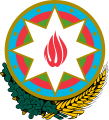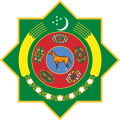Rub el Hizb
It has been suggested that Seljuk star be merged into this article. (Discuss) Proposed since October 2024. |
This article needs additional citations for verification. (March 2024) |
| ۞ | |
|---|---|
Rub el Hizb | |
| In Unicode | U+06DE ۞ ARABIC START OF RUB EL HIZB |
The Rub el Hizb (Arabic: رُبْعُ الْحِزْبِ or رُبُعُ الْحِزْبِ, romanized: rubʿ al-ḥizb, lit. 'quarter of the party') is an Islamic symbol in the shape of an octagram, represented as two overlapping squares ۞. While its main utility today is to mark a division inside some copies of the Quran to facilitate recitation, it has originally featured on a number of emblems and flags in the past and continues to do so today. It has traditionally been called the Seljuk Star.
In Arabic, rubʿ means 'one-fourth' or 'quarter', while ḥizb (plural aḥzāb) translates to 'a group'. The Quran is divided into 60 aḥzāb (groups of roughly equal length in turn grouped into 30 ajzāʾ), with instances of Rub el Hizb further dividing each ḥizb into four, for a total of 240 divisions.
History
[edit]The symbol was used as a cultural symbol in the time of Al-Andalus in the Iberian Peninsula, appearing on the coins. In addition, the use of it in so many areas[which?] led to its name being changed to "the star of Abd al-Rahman I". From al Al-Andalus it was exported to the rest of the Arab world. It has also been used extensively in Turkic Islamic culture and history.[1][2]
Variants
[edit]-
Interlaced
-
Outline
Contemporary use
[edit]Architecture
[edit]
The symbol has been used as a basis for plans of buildings, as in the case of the Petronas Towers.
Former flags
[edit]-
An Ottoman flag with an eight pointed star (after 1844)
-
Flag of the Emirate of Afghanistan (1919–1926)
Current flags
[edit]-
Standard of the President of Turkmenistan
-
Standard of the President of Uzbekistan
Emblems
[edit]See also
[edit]References
[edit]- ^ "Eight-Pointed Star Meaning". Antique Rugs by Doris Leslie Blau. 2019-02-01. Retrieved 2023-09-11.
- ^ Reki, Mahina; Arslan Selçuk, Semra (2018-05-22). "Evolution of Geometric Patterns in Islamic World and a Case on the Jalis of the Naulakha Pavilion in the Lahore Fort". Gazi University Journal of Science. Part B: Art, Humanities, Design and Planning. 6 (1): 83–97.
- ^ Galal Abada (2004). "Petronas Office Towers" (PDF). Kuala Lumpur, Malaysia. Archived from the original on 2012-10-01.
{{cite web}}: CS1 maint: unfit URL (link)













